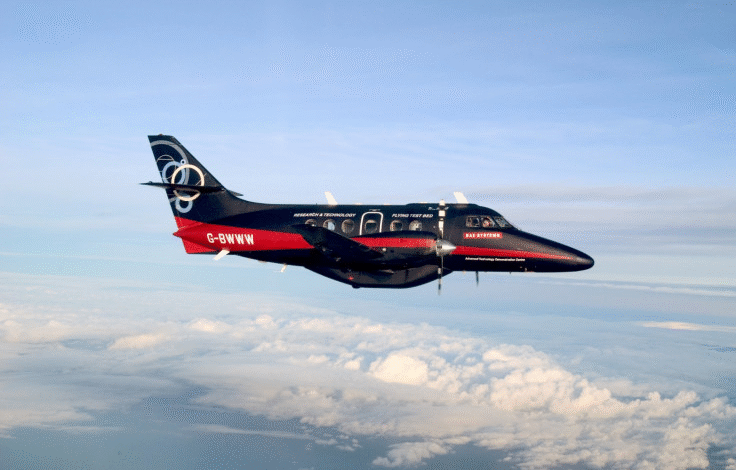Pilotless Planes: Ehang’s Rise in China’s Aviation Market

Pilotless planes are revolutionizing the skies, particularly in China, where a groundbreaking development has sparked interest among investors. As the air taxi market expands, Ehang has emerged as a leader after receiving certification from China’s aviation authorities, allowing it to transport passengers in its innovative eVTOL aircraft. This landmark achievement signifies a new era in aviation, promising not only cutting-edge technology but also unprecedented opportunities for tourism and urban transport. According to Bank of America stock analysts, now is the ideal time to invest in Ehang, with predictions of substantial growth and market dominance in the coming years. With the ongoing advancements in the China aviation market, the potential of pilotless planes is rapidly becoming a reality that could transform how we travel in airspace around the globe.
Unmanned aircraft are gaining traction as a transformative force in modern transportation, particularly in the burgeoning realm of air taxis and electric vertical takeoff and landing (eVTOL) vehicles. In China, an enthusiastic push towards certification and deployment of pilotless aircraft is creating a vibrant marketplace poised for growth. Ehang stands out as a pioneering company, setting the pace with its recent approvals that enable commercial passenger transport. Furthermore, with the support of policy initiatives aimed at bolstering the low-altitude economy, these advanced flying vehicles are positioned to reshape not just tourism, but also emergency and logistical operations. The developments within the Chinese aviation landscape highlight an exciting shift in how we may perceive and utilize air travel in the near future.
The Rise of Pilotless Planes in China
Pilotless planes are emerging as a revolutionary advancement in aviation technology, particularly in China where regulatory frameworks are enabling rapid development and certification. The introduction of eVTOL aircraft, specifically designed for urban air mobility, marks a significant milestone. Unlike traditional aircraft, these innovative vehicles can take off and land vertically, allowing them to operate in confined urban spaces. With Ehang being the first to receive certification for passenger transport, it’s clear that the concept of pilotless planes is moving from mere experimental prototypes to a viable mode of transportation for the masses.
As China embraces this evolution in aviation, the government has demonstrated support through policy measures aimed at fostering the low-altitude economy. This transformative approach not only includes infrastructure investments but also extends to various players developing pilotless technology, from food delivery drones to more complex passenger-carrying aircraft. The increasing focus on pilotless planes highlights how nations are gearing up to redefine transportation, aligning with a broader trend of sustainable, efficient transport solutions.
Ehang’s Leadership in the eVTOL Market
Ehang has solidified its position as a leader in the burgeoning eVTOL aircraft market, particularly following its recent certification for passenger flights in China. This certification places Ehang at an advantage, as analysts predict it will maintain a dominant market share in the face of stringent regulatory barriers that prevent other competitors from easily entering the space. With a focus on tourism and urban transportation, Ehang’s strategic initiatives align perfectly with the growing demand for pilotless planes, which promise to alleviate urban congestion and provide innovative travel solutions.
The forecasted growth for Ehang is robust, with projections indicating potential revenue surges as the company hones its delivery capabilities and expands its operational reach. Furthermore, Bank of America analysts are optimistic about Ehang’s path, expecting significant increases in sales volume driven by supporting national policies. As the air taxi market begins to develop, Ehang seems poised to not only maintain its lead but also become synonymous with the eVTOL revolution in China and potentially beyond.
Investment Prospects for Ehang and Pilotless Technology
Investing in Ehang represents a compelling opportunity in the context of a rapidly evolving aviation sector. As highlighted by Bank of America, the stock’s potential growth by 36% could be driven by the increasing acceptance of pilotless planes, an expanding air taxi market, and the overall development of the eVTOL sector in China. The analysts suggest that Ehang’s unique positioning allows for potentially unprecedented market leadership through its innovative eVTOL designs and strategic operations.
Moreover, the expansion into services such as short-haul air taxis could provide additional revenue streams, with expectations that demand might reach 200,000 eVTOL air taxis by 2035. Such trends demonstrate a diversification of the aviation market and illustrate the potential long-term profitability of investments in companies like Ehang. Similar advancements in other regions, such as the U.S. and Europe, may further validate the market space, which encourages investors to consider the implications of pilotless planes as a significant shift in both technology and consumer behavior.
Challenges Facing Pilotless Planes and the eVTOL Market
Despite the promising outlook for pilotless planes, several challenges remain that could impede growth. Concerns surrounding safety and regulatory hurdles persist, as public acceptance of these new technologies is crucial for widespread adoption. Incidents or accidents involving eVTOL aircraft could negatively impact public perception and investor confidence, potentially stalling progress within the fast-evolving sector. Moreover, the regulatory landscape must adapt quickly to ensure public safety while promoting innovation.
In addition, competition from international players like Joby Aviation and Archer Aviation highlights the intense rivalry within the eVTOL ecosystem. While Ehang currently holds a strong position in China, the global market is rife with potential game-changers capable of disrupting established players. Future developments in safety technology, operational standards, and competitive pricing will be critical in determining who leads the market in this transformative era for pilotless aviation.
Urban Air Mobility: The Future of Transportation
The urban air mobility market is becoming increasingly tangible as cities look for innovative solutions to combat congestion and reduce travel times. With pilotless planes like Ehang’s eVTOL coming to the forefront, the prospect of aerial taxis is becoming more than a concept; it is poised to transform daily commutes. As urban populations grow, the demand for short-distance air travel is anticipated to increase, making it crucial for city planners and policymakers to integrate these new technologies into existing transport frameworks.
Moreover, national initiatives, particularly in China, underscore the government’s commitment to advancing the low-altitude economy. Investments in infrastructure, supportive policies, and strategic partnerships are being implemented to seamlessly integrate eVTOL operations into the transportation ecosystem. As urban air mobility progresses, it is anticipated that pilotless planes will play a vital role in reshaping how people navigate their cities, bringing us closer to a future where aerial travel becomes a common sight in our urban landscapes.
Ehang’s Competitive Edge in Certification and R&D
Ehang’s successful acquisition of aviation certification in China highlights its competitive edge in a market that is still maturing globally. While many companies are in various stages of developing eVTOL technologies, Ehang’s position as the first to receive certification places it ahead of the pack. This regulatory milestone is crucial as it not only boosts consumer confidence but also accelerates the company’s ability to bring its products to market in a country eager for innovation in transportation.
In conjunction with this certification, Ehang’s investment in research and development is shaping its future trajectory. The company’s focus on enhancing safety, efficiency, and user experience is essential for maintaining its leading role amidst growing competition. As advancements in technology continue, Ehang is strategically positioned to leverage its findings, ensuring that it remains at the forefront of not just certification but also in setting the standards for eVTOL aircraft globally.
Forecasting the Growth of the Air Taxi Market
The air taxi market holds vast potential, especially with projections indicating rapid growth in the next decade. Analysts from Bank of America estimate that the demand for eVTOL air taxis could surge, paralleling the well-established taxi and ride-hailing markets. This potential shift towards air transportation is fueled by the rapidly urbanizing population and increasing traffic congestion, pulling the attention of investors and leading firms alike. With Ehang positioned as a frontrunner, it stands to benefit greatly from these shifts in consumer mobility.
Furthermore, as urban planners and governments envision transportation solutions that integrate aerial vehicles, the demand could lead to an entirely new market ecosystem. Ehang’s emphasis on serving as the official air taxi provider opens doors not only for immediate returns but also sets a foundation for long-term growth. The success of such ventures will rely on consumer adoption rates, regulatory developments, and technological advancements, all of which will shape the dynamics of the air taxi market in the years to come.
The Role of Policy in Shaping Future Aviation Trends
Government policy plays a critical role in shaping the future of aviation, especially in the realm of pilotless planes and eVTOL operations. In China, the government is actively promoting the development of a low-altitude economy, with various initiatives aimed at encouraging investment and technological advancement in the aviation space. Such policies not only facilitate the certification of vehicles like Ehang’s but also foster an environment where innovation can thrive, ensuring that companies operating in this nascent industry can navigate regulatory hurdles more effectively.
As governments around the world take a closer look at the potential of pilotless planes, the balance between ensuring safety and encouraging growth becomes key. In the U.S., the FAA is working to develop regulations that will allow for the safe operation of passenger-carrying eVTOL aircraft. This push signifies a broader recognition of the need for integrated policies that can support emerging aviation technologies while safeguarding public interests. As the global aviation landscape continues to evolve, the interplay of policy and market readiness will be pivotal in determining the trajectory of pilotless planes.
Understanding the Economic Impact of eVTOL Technology
The emergence of eVTOL technology is poised to create significant economic opportunities across various sectors. From manufacturing and engineering to tourism and logistics, the introduction of pilotless planes reshapes the economic landscape by creating new jobs and fostering innovation. As companies like Ehang begin to roll out their eVTOL aircraft, the ripple effects are likely to extend beyond aviation into related industries that support these technologies, enriching the broader economic fabric.
Furthermore, the potential revenue streams from air taxi services could have a transformative impact on urban economies. Analysts project that the deployment of thousands of eVTOLs could lead to increased accessibility in urban centers, stimulating local economies through tourism and enhanced transit options. This economic potential underscores the importance of continued investment in eVTOL infrastructure and technology, and highlights the role of pilotless planes as a catalyst for future economic growth in cities around the globe.
Frequently Asked Questions
What is the significance of pilotless planes, specifically eVTOL aircraft, in the aviation market?
Pilotless planes, particularly eVTOL aircraft, are revolutionizing the aviation market by offering innovative solutions for urban transport. These electric vertical take-off and landing vehicles are designed to operate without a pilot, significantly reducing operational costs and increasing efficiency in air travel, especially in congested urban areas.
How has Ehang achieved certification for its pilotless planes in China?
Ehang has been certified by China’s aviation regulator to operate its pilotless passenger aircraft, marking a significant milestone in the eVTOL sector. This certification allows Ehang to commence commercial flights for tourists along designated routes, positioning it as a leader in the burgeoning air taxi market in China.
What are the implications of Bank of America’s stock rating for Ehang, given the rise of pilotless planes?
Bank of America has issued a ‘buy’ rating for Ehang, predicting that the company will maintain a dominant position in the eVTOL market from 2025 to 2027. Analysts anticipate that the growth and innovation in pilotless planes will drive up Ehang’s stock value, making it an attractive investment opportunity.
How is the urban air taxi market expected to evolve with the rise of pilotless planes?
The urban air taxi market is expected to expand significantly with the development of pilotless planes, such as eVTOL aircraft. Industry analysts predict that as demand for quick and efficient transportation increases, eVTOL air taxis could potentially reach a market demand of 200,000 units by 2035, driven by urbanization and the need for innovative transport solutions.
What challenges do pilotless planes face in their adoption, according to recent reports?
Pilotless planes, including eVTOL aircraft, face challenges such as strict safety regulations and potential setbacks from accidents or technical failures. Any incidents impacting passenger safety could significantly harm companies like Ehang and slow down the adoption of pilotless flight technologies in the aviation market.
In what ways is the China aviation market supporting the growth of pilotless planes?
The China aviation market is actively supporting the growth of pilotless planes by investing in low-altitude economy initiatives and providing subsidies for eVTOL operations. With around 300 local governments planning related infrastructure, the environment is favorable for the proliferation of pilotless aircraft, enhancing the potential for widespread adoption.
How does Ehang’s 216-S model compare to other pilotless planes in the market?
Ehang’s 216-S model, priced at approximately $330,000 in China and $410,000 internationally, stands out in the pilotless plane market for its certification and operational readiness, unlike other models such as Joby’s S4, which costs $1.3 million but has not achieved the same level of regulatory approval.
What role will pilotless planes play in tourism and emergency services in the coming years?
In the coming years, pilotless planes are expected to play a vital role in tourism by providing unique aerial experiences and quick transport options for tourists. Additionally, they could enhance emergency services by aiding in firefighting and medical evacuations, further demonstrating the versatility and value of eVTOL aircraft in societal applications.
| Key Point | Details |
|---|---|
| Certification and Launch | Ehang’s eVTOL aircraft is the first certified to carry passengers in China, launching tourist flights by June. |
| Market Predictions | Bank of America forecasts Ehang will maintain a 100% market share in China from 2025 to 2027. |
| Global Competitiveness | Ehang is ranked first globally for eVTOL production potential, with a projected annual output of 1,000 units. |
| Pricing | The 216-S model costs about 2.39 million yuan ($330,000) in China and $410,000 internationally. |
| Market Outlook | The potential market for eVTOLs in China could reach 80,000 units, driven by tourism and emergency services. |
| Future Growth Areas | Urban air taxi market expected to grow significantly by 2035, with potential demand of 200,000 air taxis. |
| Risks | Accidents or injuries could damage Ehang’s reputation and slow adoption of eVTOLs. |
Summary
Pilotless planes are revolutionizing the aviation industry, with Ehang leading the way as the first certified passenger-carrying eVTOL in China. As market demand for these innovative aerial vehicles grows, their potential spans tourism, emergency services, and future urban air taxis. With support from the Chinese government and increasing investments, the development of pilotless planes signifies a pivotal shift towards a new era of transportation. However, stakeholders must remain vigilant regarding safety concerns that could impact public perception and adoption rates.




